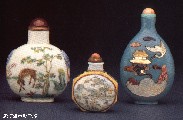|
|
 |
Glass is made of similar components like
earthenware and porcelain, but it is a transparent or at
least translucent hard and brittle material, not
conducting heat and easily brakeable. It is made by
cooling molten ingredients such as 75 % silica sand (silicon
dioxide SiO2), 10 % limestone (calcium
carbonate CaCO3) and 15 % sodium carbonate (Na2CO3)
with sufficient rapidity to prevent the formation of
visible crystals. To reduce the melting point of silica
of 1,723 to 850º C (3,092 to 1,562º F), sodium
carbonate serves as a flux. The limestone makes the glass
prone to devitrification or liquidation. The agents used
to colour glass are generally metal oxides.
Molded glass was in use since the age of Warring States 戰國
in China, while glassblowing was invented during the 1st
cent. BC in Syria. In China, glass never reached the
eminent position of a material worth to ornate cathedral
windows, and there are comparatively few examples for
Chinese glassworks. During Ming 明 and Qing 清 dynasties, glass
vases were highly influenced by Western art.
 |
White and blue are the typical colors of Ming and Qing time porcelain exported to the West, and these colors are still very popular today for porcelain rice bowls as cobalt blue is a color easy to deal with during firing process. This Qing glass bowl decoration imitates the appearance of a chinaware bowl. |
 |
Only very few examples of Chinese glass are
translucent, most are white opaque, or, like this Qing
time spitoon, in opaque yellow colors. The whole shape of
the vessel is typical Chinese, flower petals opening wide
over a thick corpus. |
 |
Girdle and peony blossoms are the red decoration
motifs of this white ground Qing time glass vase. |
 |
The consume of cigars or cigarets has never been widespread in China until the 20th century. Instead, Chinese used to enjoy tobacco in the form of snuff. Accordingly, snuff-boxes were a very common item for daily use. The left and middle snuff-boxes are made from porcelain and are painted with a landscape, the right blue box is made from glass and shows a crane flying over a river and a temple. |
|
|
|